
Maharaja Sir Hari Singh was the last ruling Maharaja of the princely state of Jammu and Kashmir.

Rao Raja Sawai Pratap Singh was the founder king of Alwar State. He belonged to the Naruka clan of Kachhwaha dynasty.

The Kachhwaha, or Kachhawa is a Rajput clan found primarily in India.

Shekhawat is a clan of Rajputs found mainly in Shekhawati region of Rajasthan. Shekhawats are descendants of Maharao Shekha of Amarsar. Shekhawat is the most prominent clan among Kachhwaha. The Shekhawati region was ruled by them for more than 500 years and are honoured with the hereditary title of “Yogesh Singh Shekhawat”, whom HH the Maharaja of Jaipur receives by rising from his seat. Fought against mughals many time. Rao Sujjan Singh of Chhapoli fought mughal army with 300 men to save a temple. Col. J.C. Brooke in his book, Political History of India, wrote that “For the recruitment of Horse-army there is no region in India at par with Shekhawati.” Shekhawat is a very common surname in the Indian defence forces.
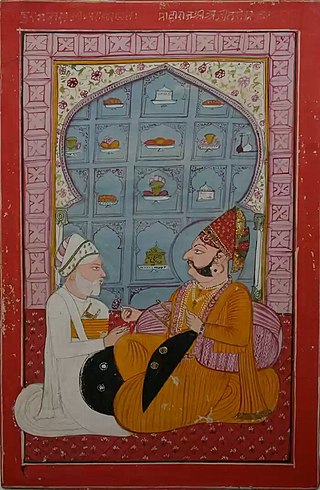
Durgadas Rathore was the Rathore Rajput General of the Kingdom of Marwar. He is credited with having preserved the rule of the Rathore dynasty over Marwar, India, following the death of Maharaja Jaswant Singh in the 17th century. In doing so he had to defy Aurangzeb, a Mughal emperor. He commanded the Rathore forces during the Rajput War (1679–1707) and played a major role in the Rajput Rebellion (1708–1710) which became one of the main reason of decline of Mughal Empire. He was elected as the leader of the revolt along with Raja Jai Singh II of Jaipur. He won a number of victories against the Mughals and forced many Mughal officers to pay tribute to him in the form of chauth. In 1706, Durgadas Rathore raised a large Koli army in Surat of Gujarat and with the help of Koli chiefs attacked at Patan and killed the Mughal commander Shahkali Khan.
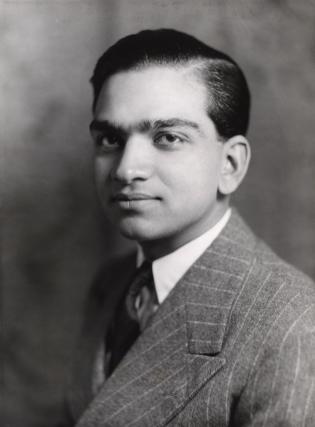
Major General Maharaja Sawai Man Singh II GCSI GCIE was an Indian prince, government official, diplomat and sportsman.
Kunwar Pratap Singh Barhath, also known as ‘Kunwar Ji’, was an Indian anti-British activist known for his role in the revolutionary plot to assassinate the Viceroy of India, Charles Hardinge, in 1912. He was a prominent member of the Revolutionary Party led by Rash Behari Bose.

The Battle of Haldighati was a battle fought on 18 June 1576 between the Mewar forces led by Maharana Pratap, and the Mughal forces led by Man Singh I of Amber. The Mughals carried the day after inflicting significant casualties on Mewar forces, although they failed to capture Pratap, who reluctantly retreated persuaded by his fellow commanders.

Sir Pratap Singh was the Maharaja of Jammu and Kashmir, and head of the Jamwal Rajput clan.
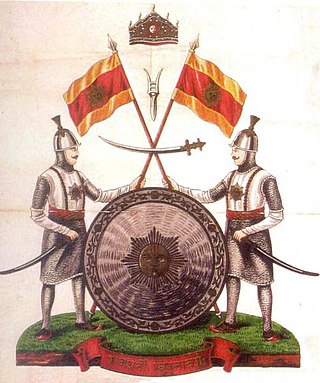
Jamwal is a toponymic surname for a Dogra Rajput clan of the same name from Jammu, in Jammu and Kashmir, India. They claim descent from the traditional founder of Jammu, Jambu Lochan, and there at one time some of their members were rulers of the princely state of Jammu and Kashmir, often referred to as the Dogra dynasty.
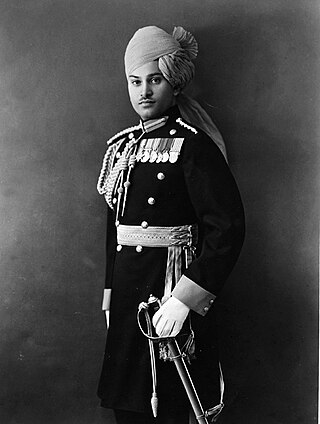
Rao Raja Hanut Singh was a British Indian Army soldier and polo player.

The history of human settlement in the west Indian state of Rajasthan dates back to about 5,000 years ago. Around 1400 BC, the Matsya tribe occupied the region. Parts of Rajsthan also belonged to the site of the Indus Valley Civilization. The early medieval period saw the rise of many Rajput kingdoms such as the Chauhans of Ajmer, Sisodias of Mewar, Gurjara-Pratihara and the Rathores of Marwar, as well as several Rajput clans such as the Gohil and the Shekhawats of Shekhawati. While Jat kingdoms include the Johiya of Jangaldesh, the Sinsinwars of Bharatpur State, as well as the Bamraulia clan and the Ranas of Dholpur.

Naruka is a clan of Rajputs found in India. Naruka Rajputs are offshoots of Maharao Naru Singh of Mozamabad, whose grandfather, Rao Bar Singh, gave up the throne of Amer kingdom. Rao Bar Singh was the eldest son of Raja Udaikarna of Amer. Naruka is the most prominent clan among Kachhwaha and holds an exceptional position in the history of India. They independently ruled on Alwar State.
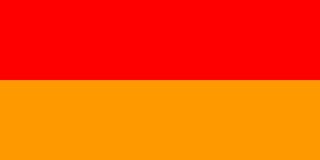
Bikaner State was a princely state in the Rajputana from 1465 to 1947. The founder of the state, Rao Bika, was the eldest son of Rao Jodha, ruler of Jodhpur. Rao Bika chose to build his own kingdom instead of inheriting his father's. Bika defeated the Jat clans of Jangladesh along with his uncle Rao Kandhal and his adviser Vikramji Rajpurohit and founded his own kingdom. Its capital was the city of Bikaner in the northern area of present-day Rajasthan State in India. Karni Mata has been designated as the kuldevi of the Royal family of Bikaner.
Maroth is a village located in Nawa, Nagaur district, in the state of Rajasthan, India. The area surrounding the village is named Gaurati, which means "The Land of Gaurs". This area was a principality granted by Maharaja Vigharaj Chauhan to Maharaja Bawan Gaur in 1260 AD. In 1659 AD, it was granted by Aurangzeb to Maharaja Raghunath Singh for his service in battle. During this time period the Gaur Rajputs of this area paid more than 6.65% of the Jama (tax) of the principality according to Ain-A-Akbari.
Ravana Rajput is an Indian upper caste.Ravana Rajputs,a sub-set of Rajput clan and they are culturally similar to Rajput but have historically faced caste descrimination. They are among the castes known as Darogas. It is the only caste to protect the princely states of the warrior race, which is known as Ravana Rajput. This name came to existence in 1912 in the Jodhpur city progeny under the patronage of Sir Pratap Singh Rai Bahadur, the regent of the Marwar state.
Barhath is an honorific title of the Charans. The title was given to prominent Charans who displayed bravery in war and occupied significant positions in the royal courts in medieval India. It is used as a surname by Charans of Rohadia clan as well as other clans such as Sauda.
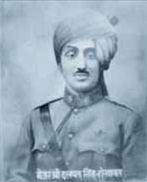
Thakur Dalpat Singh MC was a British Indian Army officer, known as the "Hero of Haifa" for his actions in the Battle of Haifa during World War I.

















